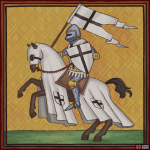Text
The first knightly orders emerged at the end of the 11th century, primarily in connection with the Crusades. They were a combination of religious order and military organization, appealing to Christian values as well as chivalric traditions and service to society. Besides noble knights, the members of the order also included a large number of common people: foot soldiers, archers, sailors, and auxiliary military professions.
Becoming a member of a knightly order might have seemed like a suitable career choice for a young medieval man, but often the opposite was true. Life was subject to strict rules and organization, often requiring celibacy, life in a closed convent, or long fasts. For example, the Templars forbade paying ransom for their members, so falling into enemy hands meant only imprisonment or death.
In the High Middle Ages of the 13th and 14th centuries, the orders experienced their greatest expansion, with their armies numbering tens of thousands of fighters, and in some cases, they even founded their own states (such as in the Baltic region or later in Malta). In more recent history, their religious and ecclesiastical context has faded, and the orders have focused more on charity.
The most famous knightly order is the Templars, followed by the Order of St. John (Order of the Knights of Malta), the Teutonic Order, the Knights of the Holy Sepulchre, and the Knights of St. Lazarus.


No Comments